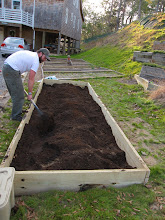The gardening books are on the sale rack in the bookstoors. It was sixty five degrees Friday and they are calling for a high of thirty nine on Monday. Let the guessing game begin! When to start and what to start with. It's definitely time to have some seedlings going in the garage, and ponder that ominous question; what does, "after danger of heavy frost," really mean anyway. One of Grow Your Own's good friends Diana has offered the following helpful information:
What’s available now?
Potatoes:
Kennebec
Russet
ž If you’re going to grow potatoes in garden boxes, I would recommend establishing one box for potatoes only. Make sure your potatoes grow in full sun.
ž Soil should not be limed and go ahead and throw a bag of manure into the soil mix where you plan to grow your potatoes for extra nutrients.
žTo get started you should cut your potatoes into small pieces which have “eyes”, or sprouts growing.
ž Let these pieces dry out for 3 to 5 days. Once dried dig your trenches shallow 4” to 6” deep.
ž Place your sprouted potato pieces into the dirt 12” apart from each other and cover with dirt.
ž Once your potatoes have established themselves, make sure you “hill” your plants with surrounding dirt. (Pushing surrounding dirt up to the stems of the plant to assure the potatoes don’t poke out of the ground. If they do, this will cause the potatoes to green and become inedible.)
ž You could also use a straw mulch to keep the soil covered around the potatoes instead of “hilling”.
ž During growing season water potatoes every other day.
Sugar Snap Peas:
ž Grow these long vines onto trellis in full to partial shade.
ž During growing season water everyday.
ž When ready to harvest pick ripe beans, but don’t forget the old beans too. If you don’t pull off the old ones the plant with trigger itself a chemical that will cause the plant to stop growing beans. Leave the younger beans on the vine to finish ripening.
ž Once your beans are out of season it’s time to make room for your other vining plants. A breed of cherry tomatoes will do, or even cucumbers, but you have to train these species to the trellis (soft twine will work).
Onions:
Green Scallions
Red Onion
žGrow in full sun and in long rows. Limed soil is good.
ž Dig your trenches about 3” deep. Add manure or compost to soil mix.
ž Moisten the soil before laying down your bulbs.
ž Plant bulbs 2” apart and cover.
ž Green onions can be harvested once the tops are long, 8” to 10”.
ž Red onions can be harvested once the tops turn yellow and fall over.
ž Pull the ripe onions out of the dirt at this point and let them dry out in the sun.
If you've already got a garden going, this is great advice. If you need a garden, you know who to call.
Subscribe to:
Post Comments (Atom)



Grow Your Own
ReplyDeleteLove your site. Can you tell me when should I plant my turnip seeds? I know they are a cool weather crop, but we could have frost until mid May here in Virginia.
Lynn M
Lynn,
ReplyDelete(who happens to be my mom) We will be planting turnips and radishes in the next three or four weeks. Though VA is a little chillier, you do enjoy the same shifts in weather that we have in early spring here. So give it four or five weeks and then give some a shot. If the weather stays mild, you get an early harvest, if not, well, you don't. Good luck, and let us know how it goes. How are the garlic plants looking?
Marc
This is an amazing idea! My family is a family of 3 and we spend between $600-$800 a month on grocery's, and the most expensive part...VEGGIES! We have to sacrifice quality for price every shopping trip (Food Lion veggies don't touch Harris Teeters) I have been thinking of a vegetable garden for months but have a hard time knowing where to start. Thanks, we will be in touch!
ReplyDeleteThanks for the comment Whitney. Let us know if we can help out.
ReplyDelete